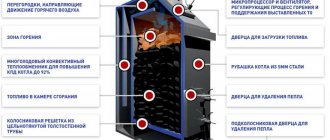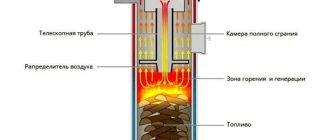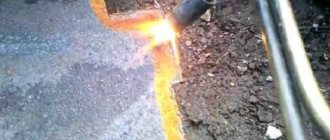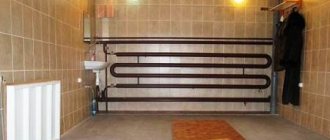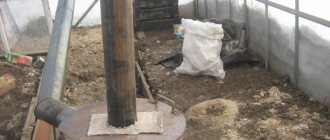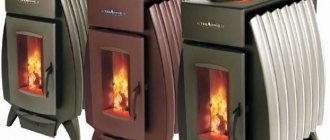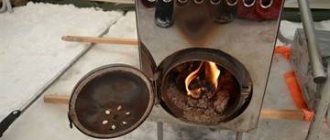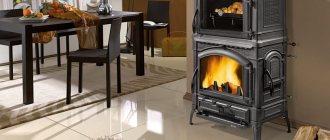Drawing of a simple long-burning boiler
This design of a solid fuel boiler is quite simple. The heat exchanger can be made of sheet steel in the form of a “water jacket”. To maximize heat transfer efficiency and increase the contact area with flame and hot gases, its design includes two reflectors (protrusions inward).
Drawing of a simple solid fuel boiler
In this design, the heat exchanger is a combination of a “water jacket” around the combustion chamber and an additional slot-like sheet metal register in its upper part.
Diagram of a boiler with a slot-type heat exchanger
1 - chimney; 2 - water jacket; 3 - slot heat exchanger; 4 - loading door; 5 - firewood; 6 — lower door for ignition and cleaning; 7 - grate; 8 - door for regulating air supply and cleaning the ash pan.
In these options, the “water jacket” is supplemented with heat exchange registers made of pipes in the upper part of the combustion chamber. In addition, such units are designed for cooking food on them. Option 4 is more powerful and has a top loading door.
Rice. 3 Designs of solid fuel boilers with additional registers and hob
1 - firebox; 2 - register made of pipes; 5 — return pipe; 6 - supply pipe; 7 - upper loading door; 8 — lower door for ignition and air supply; 9 — loading door; 10 - chimney; 13 — grate; 14,15,16 — reflectors; 17 - damper; 19 — water jacket; 20 - ash pan; 21 - hob.
Positive qualities of using a potbelly stove with a water jacket
The furnace with a cavity for heating the coolant is designed in such a way that hot vapors wash the container on each side, which makes it possible to maintain a high temperature for a long time. In addition, a similar potbelly stove stands out as follows:
- A potbelly stove with a hydraulic circuit provides high productivity. The cost of creation and operation will be much less when compared with other furnaces.
A potbelly stove with a hydraulic circuit can be created from waste material, which also saves money.
- To ignite the stove, you can use available fuel: coal, firewood and various vegetable wastes.
- A potbelly stove with a water jacket does not require an electricity supply. It operates on the principle of gravitational circulation.
Top combustion boiler
This unit differs from the previous ones - firstly, in its shape (it has a round cross-section and can be made from pipes of different diameters), and secondly, in the method of burning fuel in it (it is burned in it from top to bottom). In order to ensure such a combustion process, it is necessary to provide air supply from above, directly to the combustion site. This function here is performed by an air supply telescopic pipe, which rises up when loading fuel and falls down after igniting the fuel. As it burns gradually, the pipe falls down under its own weight. A “pancake” with blades is welded to the bottom of the pipe to ensure uniform air supply.
To ensure better fuel combustion conditions, an air heating chamber is located in the upper part. The air supply, and therefore the burning rate, is regulated by a valve at the entrance to this chamber from above. The heat exchanger here is made in the form of a “water jacket” around the combustion chamber.
Drawing of a top combustion solid fuel boiler
1 - outer wall (pipe); 2 - inner wall; 3 - water jacket; 4 - chimney; 5 — telescopic air supply pipe; 6 — air distributor (metal “pancake” with ribs; 7 — air preheating chamber; 8 — air supply pipe; 9 — supply pipe with heated water; 10 — air damper; 11 — loading door; 12 — cleaning door; 13 — pipe with water from the system (return); 14 — cable controlling the damper.
Operational Features
The use of a potbelly stove has a number of special characteristics:
- The smoke exhaust duct must be led outside through a wall or ceiling. Connecting the pipe to the ventilation system is prohibited. The intersection points must be insulated with non-flammable materials.
- Modern metal stoves are capable of efficiently heating one room up to thirty meters 2. At the same time, it must be well insulated.
- For a larger heated area, it is necessary to use a traditional heating system from the same stove.
- In a room with such a stove, you should have a box of sand and keep a container of water ready.
- It is best to equip a separate room in the house with a supply of firewood for a potbelly stove, since fuel consumption is high.
Compliance with operating rules and fire safety will protect your property and health.
Boiler with pyrolysis combustion of solid fuel
The difference between this design is that solid fuel does not burn in it, as in a conventional one, but if there is a lack of primary air supply, it is “distilled” into wood (pyrolysis) gas, which is burned in a special afterburner chamber when secondary air is supplied to it. Such a presentation can be either natural or forced.
Scheme-drawing of one of the variants of a pyrliz boiler
1 — draft regulator with temperature sensor; 3 - firewood; 4 - bottom door; 5 - grate; 6 — air damper for primary air supply; 7 - ash pan; 8 — grate; 10 — cleaning; 11 - drain; 12 — thermal insulation of the body; 13 — return (coolant supply from the system); 14 — nozzle; 15 — secondary air supply; 16 — chimney damper; 17 - pipe with heated water; 18 — damper; 21 — loading door; 22 - afterburning chamber.
Useful additions
To upgrade a homemade unit, you will have to buy some components for solid fuel boilers. This includes control and safety devices: thermometer, pressure gauge, automatic air vent and safety relief valve. You can also add an air blower, a smoke exhauster and automation to them. The supercharger is placed on the housing cover; a separate opening will need to be made for it. The remote control and display of the control unit are mounted on the wall.
Security group
To protect against boiling over, the safety group of a solid fuel boiler is used. It includes a pressure gauge, air vent and relief valve mounted on one manifold. The group is installed on the outlet pipe of the coolant without the use of shut-off valves.
To regulate the intensity of combustion, you need to install a thermostat, which you can also make yourself. In the simplest case, this is a damper attached to the top of the air pipe. With its help, you can manually block part of the pipe flow area and reduce the amount of combustion air. When automating, a temperature sensor is placed in the jacket of the unit and connected to the control unit.
In some cases, forced draft creation is practiced using a fan at the flue gas outlet. Such a smoke exhauster is mounted in a chimney pipe on a horizontal section. However, this leads to an increase in the cost of the design, since a fan must be used as a smoke exhauster that can withstand the temperature of the moving medium up to 200 ⁰C.
Shaft type boilers
As already mentioned, a feature of such boilers is the presence of two chambers: a large vertical loading chamber (shaft) and a chamber with a heat exchanger. The fuel is ignited from below in the first chamber and the flame enters the other through a hole, where it transfers its energy to the coolant through a heat exchanger.
Such boilers can be either with conventional fuel combustion or with pyrolysis. In the first case, all the necessary air is supplied through the lower door, and the combustion products, after passing through the heat exchanger, are removed into the chimney. In the second case, a limited amount of primary air is supplied to the combustion site, where the wood burns, releasing pyrolysis gas. In addition, such structures are equipped with an additional afterburning chamber, where secondary air is supplied and gas is burned. At the top of the heat exchange chamber there is a valve that opens when ignited and allows the flue gases to escape directly into the chimney.
Drawing diagram of a shaft-type boiler with an afterburner chamber
1 — primary air supply damper; 2 - lower door for ignition and cleaning; 3 - grate; 4 - firewood; 5 — loading door (can be located on top); 12 - pipe with heated water (supply); 13 — starting valve; 14 — chimney damper; 15 - heat exchanger; 16 — secondary air supply; 17 — afterburning chamber; 18 — return; 19 — drain; 20 - cleaning; 21 - damper; 22 — grate; 25 - ash pan.
Diagram of a shaft-type boiler with lining of the inner surface of the combustion and afterburning chambers
Water heating with wood
This more complexly organized system is a pyrolysis boiler. consisting of two sections. In the lower one, wood is burned, and in the upper one, the gas generated due to combustion circulates. Thanks to the scheme in which gas does not immediately enter the chimney. its efficiency increases, and longer burning requires less wood.
Around the boiler there are thick pipes through which water flows, heated from it. Keep in mind that only dry firewood is suitable for a boiler of this type, so you should always have a good supply of it at home.
There are also systems that use hot air instead of water for heating. It passes through the circuit and is transmitted into the airspace of the house. The cold air, falling down, again enters the boiler for further heating.
Do-it-yourself solid fuel boiler for ultra-long burning
A homemade heater will have the following design:
- The firebox is a “box” 460 mm deep, 360 mm wide and 750 mm high with a total volume of 112 liters. The fuel load volume for such a combustion chamber is 83 liters (the entire volume of the firebox cannot be filled), which will allow the boiler to develop power up to 22 - 24 kW.
- The bottom of the firebox is a corner grate on which the firewood will be placed (air will flow into the chamber through it).
- There should be a 150 mm high compartment under the grate to collect ash.
- The 50 liter heat exchanger is mostly located above the firebox, but its lower part covers it on 3 sides in the form of a 20 mm thick water jacket.
- A vertical flue pipe connected to the top of the firebox and horizontal flame pipes are located inside the heat exchanger.
- The firebox and ash pan are closed with sealed doors, and air is taken in through a pipe in which a fan and gravity damper are installed. As soon as the fan turns off, the damper lowers under its own weight and completely blocks the air intake. As soon as the temperature sensor detects a decrease in the temperature of the coolant to a user-specified level, the controller will turn on the fan, the air flow will open the damper and a fire will break out in the firebox. Periodic “shutdown” of the boiler in combination with an increased volume of the firebox allows you to extend operation on one load of fuel up to 10 - 12 hours with wood and up to 24 hours with coal. The automation of the Polish company KG Elektronik has proven itself well: a controller with a temperature sensor - model SP-05, a fan - model DP-02.
do-it-yourself solid fuel boiler with extra long burning time
The firebox and heat exchanger are wrapped in basalt wool (thermal insulation) and placed in the housing.
The process of making a boiler with your own hands.
First of all, you need to prepare all the necessary preparations:
- Steel sheets 4 - 5 mm thick for making a firebox. Alloy steel of heat-resistant grades 12Х1МФ or 12ХМ (with additions of chromium and molybdenum) is best suited, but it needs to be welded in an argon environment, so the services of a professional welder will be needed. If you decide to make a firebox from structural steel (without alloying additives), then you should use low-carbon grades, for example, Steel 20, since high-carbon grades may lose their ductility due to exposure to high temperatures (they are hardened).
- Thin sheet steel 0.3 - 0.5 mm thick, painted with a polymer composition (decorative cladding).
- 4mm structural steel sheets for the body.
- Pipe DN50 (fire pipes inside the heat exchanger and pipes for connecting the heating system).
- Pipe DN150 (pipe for connecting the chimney).
- Rectangular pipe 60x40 (air intake).
- Steel strip 20x3 mm.
- Basalt wool 20 mm thick (density - 100 kg/cubic m).
- Asbestos cord for sealing openings.
- Factory made door handles.
Welding of parts should be performed with MP-3S or ANO-21 electrodes.
DIY heat exchanger for a solid fuel boiler
First, the firebox is assembled from two side, one rear and one upper walls. The seams between the walls are made with full penetration (they must be airtight). A 20x3 mm steel strip is welded horizontally from below to the firebox on 3 sides, which will serve as the bottom of the water jacket.
Next, to the side and rear walls of the firebox, you need to weld short pieces of small-diameter pipe in a random order - the so-called clips, which will ensure the rigidity of the heat exchanger structure.
Now the outer walls of the heat exchanger with pre-made holes for the clips can be welded to the bottom strip. The length of the clips should be such that they slightly protrude beyond the outer walls, to which they need to be welded with a sealed seam.
In the front and rear walls of the heat exchanger above the firebox, coaxial holes are cut into which flame tubes are welded.
All that remains is to weld the pipes to the heat exchanger for connection to the heating system circuit.
Homemade sheet metal boiler
Boiler assembly
The unit must be assembled in the following sequence:
- First, the body is made by attaching the side walls and frames of the openings to its bottom with short seams. The bottom frame of the ash pit opening is the bottom of the housing itself.
- From the inside, corners are welded to the body, on which the firebox grate pan (grid) will be placed.
- Now you need to weld the grill itself. The corners of which it consists must be welded with the outer corner down, so that the air coming from below is evenly distributed over the two inclined surfaces of each corner.
- Next, a firebox with a heat exchanger is welded to the corners on which the grate is laid.
- The doors of the firebox and ash pan are cut from steel sheet. From the inside they are framed with a steel strip laid in two rows, between which an asbestos cord must be laid.
Next, a smoke exhaust pipe and an air duct with a flange for installing a fan are welded. The air duct is led into the boiler through a hole in the middle of the rear wall just below the grate.
Now we need to weld the mating parts of the door hinges and several 20 mm wide brackets to which the casing will be attached to the boiler body.
The heat exchanger must be lined on three sides and on top with basalt wool, which is tightened with a cord.
Since the insulation will be in contact with hot surfaces, it should not contain phenol-formaldehyde binders and other substances that emit toxic volatile substances when heated.
The sheathing is screwed to the brackets using screws.
An automation controller is installed on top of the heat generator, and a fan is screwed to the air duct flange.
The temperature sensor must be placed under the basalt wool so that it is in contact with the rear wall of the heat exchanger.
If desired, the boiler can be equipped with a second circuit, allowing it to be used as a water heater.
The circuit has the form of a copper tube with a diameter of about 12 mm and a length of 10 m, wound inside the heat exchanger on flame tubes and brought out through the rear wall.
Homemade long-burning bubafonya stove with a water circuit. Photos with detailed descriptions, drawings and diagrams are presented below. The “Bubafonya” stove is one of the most economical long-burning stoves, the whole point is that two chambers are created inside the stove, namely in the first chamber solid fuel is burned, in the second the pyrolysis gases generated during the combustion of firewood are burned, there is practically no smoke at the exit and everything burns without residue, this gives the furnace high efficiency.
The slow burning stove has a fairly simple design and is a loading hopper for firewood, and it is also a combustion chamber divided into two parts as mentioned above. The most difficult thing here is the piston, which presses with its own weight on the burning wood, and air is supplied to the combustion center through the upper hole of the piston pipe; in the lower part there are blades that do not allow the burning fuel to be tightly covered and evenly distribute the incoming air over the entire combustion area. There is a gap of 2 cm between the piston skirt and the chamber wall; it is necessary for the release of pyrolysis gas and other combustion products into the second chamber where their complete combustion occurs. Thus, the firewood burns without a trace and all the thermal energy is concentrated inside the chamber - this is the most important difference from simple stoves such as a potbelly stove, where more than 50% of the heat flies into the chimney.
The stoves of the “Bubafonya” family today have several varieties, namely a stove with a water circuit which can be used to heat a residential building or garage, a Bubafonya convection stove made according to the principle of the well-known Buleryan stove, and a simple classic stove design that actually marked the beginning of the mass bubafonization of garages and workshops))
Next, we will look at and analyze the diagrams of three types of ovens: classic, with a water circuit and convection.
Materials
- gas cylinder
- sheet metal 3 -4 mm
- corner 40x40 mm
- stainless steel (for water circuit)
- profile
Tools
- welding inverter
- Angle grinder (grinder)
- plumbing and measuring tools
- skillful hands and a bright head)
Diagrams, photos with dimensions of the bubafonya stove Classic design of the long-burning stove “bubafonya”
Next, we will consider the option of a stove with a water circuit that can be used for heating a living space, as well as a garage or workshop, by first installing the stove in a separate small room, and from it having already made water heating connections to radiators and radiators. There are 2 options for installing a water jacket; in the first case, it can be on the furnace body or on the pipe, or both at once, depending on your needs.
In the second case, the water jacket is installed on the chimney.
In this case, we have presented the first option (pipe in pipe). The jacket is welded from stainless steel, in the upper and lower parts there are connections for connecting the heating system pipes. And the third type is the bubafonya convection oven, its operating principle is the same as that of the classics , only metal or aluminum profiles are welded onto the body, which promotes natural convection and air circulation, that is, cold air from below passes through the profile mounted on the body and, when heated, exits through the upper hole, such natural circulation occurs until the oven completely cools down. The well-known Buleryan stoves work on the same principle. And so, look at the diagram and photo of the stove. The stove is very economical and can work for 6-8 hours on one load of firewood; you can use sawdust, wood chips, shavings as fuel, by the way, anyone living in the city can use old furniture, it is now thrown away on every corner)) In general, all waste can be burned in this miracle stove and convert it into thermal energy for heating a garage, workshop, and a stove with a water circuit can easily heat a residential building. If you have any questions, write in the comments, we’ll figure it out together)
What does the design depend on?
The design of the heating boiler is influenced by several conditions:
- cost and availability of materials;
- Type of fuel;
- coolant circulation method.
Heat-resistant stainless steel demonstrates the greatest durability. However, it is this that has the highest price on the market, and its processing is a rather complex task that cannot be handled without special equipment. The same applies to cast iron, which, however, costs much less than stainless steel. Traditionally, for the manufacture of heating boilers, sheet steel with a thickness of 4 mm is used - this option is relatively easy to process and, most importantly, is quite reliable and durable.
To ensure natural circulation of the coolant, it is necessary to use heating circuits and connecting fittings of large diameter, and place the storage tank at a height. If this is not possible, you will have to use a circulation pump - it will reduce the diameter of the pipes. However, the heating boiler pumping system is energy-dependent, which must be taken into account when choosing the design and functionality of the unit.
Tanks for heating and cooling
Designed for storage and carrying out technological operations requiring thermal effects on the product. Used in the production and storage of food liquids in a certain temperature range. They are used in the production and storage of milk and dairy products, wine, alcoholic beverages, etc. This tank consists of a single-wall container equipped with a cooling jacket or a heating jacket. The tank lid is flat in shape. The container is placed on a pre-prepared concrete platform. Mounted on height-adjustable supports or frame. Our company will produce for you stainless steel containers with thermal insulation of the heating jacket of any volume, for any purpose and any configuration. Additionally, the container can be equipped with a mixing device, washing heads, a measuring tube, drain and fill pipes, etc. The thickness of the thermal insulation is 50 mm for containers volume up to 10 m³; 100 mm – over 10 m³. They are widely used in the processing industry - containers for preparing raw materials, containers for preparing sourdough, brewing, fat melters, boilers for making syrups, jams, sauces, cooking glazes, maturing containers, pasteurizers, normalizers.
Get a consultation:
| by mail: | [email protected] |
| by phone: | +7 |
Manufacturing materials: AISI 304, 316L, 321 stainless steel is used as materials for the manufacture of the inner cylinder of the containers. All sealing elements are made of food-grade rubber. Description The tanks are thermally insulated closed-type tanks, consisting of an inner and outer body made of AISI 304/AISI 321/AISI 316 stainless steel sheets with increased cleanliness of the inner flask seams. The containers have a thermal insulation layer, which gives them the properties of a thermos. To cool or heat the product, a coil is welded on the outer wall of the inner flask or a jacket is equipped through which the coolant or coolant flows. The bottoms of the containers are made with flanging to prevent the formation of harmful microorganisms. Typical containers
- vertical, horizontal;
- stationary, mobile;
- with a shirt, with a coil;
- with mixing, without mixing device;
- with varying degrees of automation
Heating and cooling
- ice water;
- hot water;
- steam.
Design features
- boilers with a steam jacket are equipped with pipes for supplying steam and removing condensate;
- filling/emptying pipes are provided;
- there is an overflow pipe for air and water to exit from the interwall tank;
- an air valve is provided to prevent thermal expansion;
- a hatch is used for inspection and repair;
- covers and access hatches are equipped with a limit switch for the mixing device.
Additional equipment
- cleaning filters, grilles;
- devices for connecting to a centralized washing system;
- inspection hatches, hatches with self-sealing covers, top hatches;
- instrumentation, level sensors
- means of remote automatic control
- technological process;
- electric lighting devices;
- sampling valve;
- stairs and service platforms;
- slinging devices.
Tanks with a heating jacket We have the opportunity to equip your container with special heat exchange coils. (By default, we also calculate the thermal insulation of the heating jacket and its lining with AISI 304 stainless steel sheet) To calculate the parameters of the heating jacket for the tank, we need the following parameters:
- container dimensions (height, diameter)
- container material (default AISI 304)
- liquid that will need to be heated
- required fluid temperature
In the figure, a heating jacket is shown along the contour of the container. In addition to the steam pipe system itself, we recommend that you consider equipping your steam tank heating system with condensate removal equipment and steam shut-off valves for more efficient operation. When installing a heating system, manufacturers are often faced with the problem of temperature control. We have the opportunity to equip your container with automation for precise temperature control and timely start and shutdown of heat supply. The degree of automation can vary from completely autonomous, to displaying important indicators on the operator panel and the possibility of manual control. For a more detailed calculation, we will expect from you the capacity parameters and a description of the current degree of automation:
- Will automation be needed?
- To what extent should this process be automated?
After receiving feedback, we will be ready to give a more specific proposal based on your parameters.
Model range of similar fireplaces and their average prices
- The Kratki Antek PW 8 kW fireplace insert is made of cast iron, fired by wood and costs $800.
- The German firebox Lina FD 6757 produces a thermal power of 9 kW, is made of steel, weighs 220 kg and will cost the consumer $5,300.
- The Russian Elba 600 stove from the manufacturer Meta produces a power of 10 kW, weighs 82 kg and will cost the buyer $280.
- For a French stove Supra Classigues 148C made of cast iron with a power of 13 kW, made in a classic style, you will have to pay $2,500.
- Alpha 700 from the Russian manufacturer Ecofireplace has a power of 15 kW, is made of steel and finished with fireclay, and costs $460.
- For a French Sequin Panoramic stove with a power of 17 kW you will have to pay 2800 US dollars.
- The 18-kilowatt Vega from Ecofireplace with a simple modern design, made of steel and fireclay, costs $2,300.
- The French-made Invicta 800 Chaudiere is made of cast iron and steel, has a power of 20 kW and costs $2,350.
- The Polish 30-kilowatt Kratki Amelia is made of cast iron, weighs 200 kg and costs $2,100.
Thus, it is clear that the cost of a furnace depends not only on its thermal power, but also on the country of manufacture, design, and the amount of metal used in the manufacture.
Scheme of a solid fuel boiler - we understand the structure and principle of operation
There are such lucky people in whose home all the joys of life are supported by gas heating. But, unfortunately, not all owners of country property can boast of such luck. And if you are separated from the gas main by long kilometers and years of empty promises, then it’s time to think about installing an autonomous heat supply.
Today there are a variety of ways to create warmth, coziness and comfort, but the most rational of them is installing a solid fuel stake.
Solid fuel apparatus in everyday life
Preparation work
At this step you need:
- Make a preliminary design of the furnace with details.
- Prepare financial statements for the purchase.
- Buy materials and missing tools.
- Make all the parts for the stove.
The final point is the most time-consuming and serious.
The potbelly stove can be connected to traditional heating
Basic information about solid fuel units
The high price of diesel fuel and electricity, the cost of connecting gas equipment emphasize the advisability of the decision to purchase a boiler operating on solid fuel. Based on it, it is possible to create a heating system that is independent of external energy sources, since most units of this class can operate without electricity or with minimal electricity consumption.
Solid fuel boilers are used as central units of an autonomous heating system in areas where there are problems with the supply of main gas. And in some settlements, of which there are quite a few in Russia, a wood-burning boiler is absolutely irreplaceable.
What does it consist of?
Diagram of a solid fuel apparatus
To understand how units of this class function, let's look at the design of a solid fuel boiler, which includes the following parts:
- The firebox is the so-called fuel combustion chamber and at the same time a heat exchanger. The design of the firebox includes: a portal for fuel supply, an area for removing volatile combustion products, a grate, containers for collecting ash and openings for air supply. During the combustion of solid fuel, the walls of the firebox heat up, and the water around the firebox in the water jacket of the unit heats up.
Firebox
- Water jacket. As a rule, in the firebox of a wood-burning boiler there are double walls, between which there is a coolant (hereinafter simply water) - this is the water jacket. When the fuel in the firebox begins to burn, the water in the water jacket heats up, resulting in heat flows that raise hot water to the top of the jacket. From this part of the boiler, hot water enters the heating pipe. Having passed through the entire heating system and given off heat to the room, the already cooled water returns back to the water jacket through the lower pipe. In order to speed up the movement of water throughout the system, some solid fuel boilers are equipped with special heating circulation pumps. But still, most models are designed for open heating systems (that is, for those systems where water circulation is carried out not using pumps, but by gravity). This is due to the fact that gravity systems are simple, reliable, economical and independent. They can be used even in areas where there are no signs of civilization.
Traditional unit running on solid fuel
- Carbon monoxide removal system. Due to the combustion of solid fuel, a large amount of smoke is generated in the unit itself, so a chimney is a mandatory component of such devices. The smoke is removed using heat-insulated pipes leading from the boiler to the street.
Chimney installation diagrams
Note! Some models are also equipped with forced ventilation units.
Design of a solid fuel unit with forced ventilation
- Temperature control and regulation system. It is no secret that any combustion is simply impossible without air supply. And, it should also be noted that the intensity of combustion depends on the intensity of air supply to the firebox. And the design of solid fuel boilers involves regulating the air supply using mechanical dampers and dampers. This control system is very simple and reliable - the damper is tightly connected to a special regulator. When the temperature rises excessively, the walls of the regulator expand and the damper lowers, thereby reducing the air supply to the firebox. When the regulator cools down, the reverse process occurs - the damper rises, thereby increasing the air supply and, as a result, the combustion intensity. Of course, this method may seem very primitive and outdated. However, it is also the most efficient, which is why it is used in many models of solid fuel heating boilers. In addition, it still has no competitors, since the operation of such a mechanism does not require electricity, which costs a lot of money.
Classifications
A modern heating scheme with a solid fuel boiler can include both the simplest single-circuit devices and the most powerful, high-performance and multifunctional units. Let's look at what classifications solid fuel boilers are divided into.
According to the material of manufacture:
- Steel units. Cheaper than their cast iron counterparts, easier to maintain and much easier to clean with your own hands. But they are very demanding on the temperature in the return pipeline of the heating system (at least +60°C). Therefore, they need to install special valves that maintain the required return temperature (that is, hot water from the supply pipeline is mixed into the return pipeline).
Steel model Logano S121
- Cast iron units are durable, but they are more difficult to maintain. Solid fuel boilers made of cast iron are recommended to be purchased in cases where they are expected to be used continuously. But buying a super reliable cast iron unit only for emergencies does not make sense. A cheaper steel boiler can handle this quite well.
Cast iron model SIME SOLIDA 4
By type of fuel used:
- Firewood, peat, woodworking waste, their derivatives in the form of special briquettes;
Logs
- Coal;
Coal
- Pellets (are granules formed as a result of processing wood, resin, pine needles and other organic materials);
Pellets
- Today there are also models that operate on absolutely all types of solid fuel.
By heat transfer method:
- Air;
- Steam;
- Water (the most popular).
According to the principle of fuel combustion:
- Traditional (we think there is no need to explain anything here).
- Long burning - the latest innovation in heating technology. Long-burning solid fuel boilers are a vertical, elongated combustion chamber, around which there is a container with water. Combustion in such a chamber occurs not from bottom to top, but from top to bottom (this process can be compared to the burning of a candle). Thanks to this system, complete combustion of the fuel is achieved, the burning time of one bookmark increases (up to 7 days), a stable and high coolant temperature and decent efficiency.
Long burning apparatus Stopuva 7
For uninterrupted and safe operation of such units, they are equipped with a fan for emergency extinguishing, a safety valve and a heating circulation pump.
Attention! Long-burning boilers are automated and therefore require electricity. And, by the way, the instructions on how to operate these devices are quite simple, and even a child can figure it out.
- Pellet - that is, operating on special pellets. They actually consist of the boiler itself, an automatic pellet supply system and a bunker. The electronic control system checks the presence of fuel in the combustion chamber, and if it is not there, it turns on the mechanism for feeding pellets from the hopper. Quite convenient, but again a volatile solution.
Nice pellet model
- Pyrolysis (gas generating) The uniqueness of this type of solid fuel boilers lies in the fact that in addition to the combustion energy of solid fuel, they also use the heat release of gases that are formed during the combustion of solid fuel. As a result, much more thermal energy is generated from a minimum volume of fuel, which means the efficiency of the unit increases and its environmental performance improves.
Pyrolysis apparatus
How does the stove work
It works on a fairly simple principle.
Heat exchanger option
Water enters the heat exchanger, which is located in the fuel part of the stove. There it is heated from the combustion of wood or other fuel. Then, the already heated water enters the radiator batteries, where the heat from it is distributed throughout the room. When the water cools, it returns to the coil, where it is heated again, etc.


